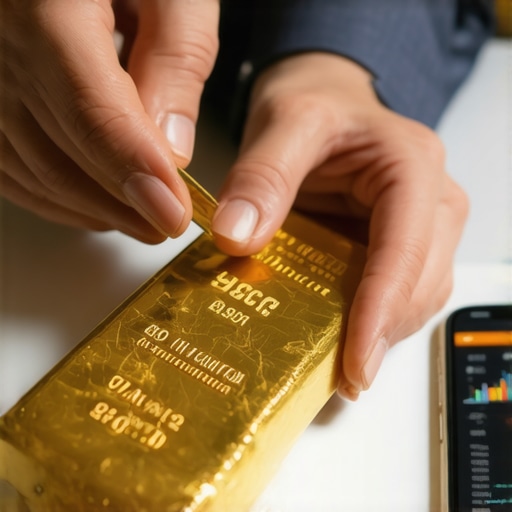Understanding the Basics of Gold Investment
Investing in gold has captivated the interest of many, especially beginners who seek stability and security in uncertain economic times. Gold is not just a shiny metal; it has been a symbol of wealth and a means of trade for centuries. However, before embarking on your journey to invest in gold, it is crucial to understand the different avenues available, the potential benefits, and the risks involved.
Why Invest in Gold?
Gold is often viewed as a safe-haven asset, which means that during times of economic instability, its value tends to remain stable or even increase. Investors flock to gold as a hedge against inflation and currency devaluation. Moreover, gold can diversify your investment portfolio, balancing out risks associated with stocks and bonds.
Types of Gold Investments
There are several ways to invest in gold, each with its own advantages and disadvantages. Here are some common types of gold investments:
- Physical Gold: This includes gold bars, coins, and jewelry. Investing in physical gold allows you to hold your asset directly, but it also involves storage and insurance costs.
- Gold ETFs: Exchange-Traded Funds (ETFs) are funds that invest in gold, allowing you to buy shares without needing to own the physical metal. This option provides liquidity and lower transaction costs.
- Gold Mining Stocks: Investing in companies that mine gold can be profitable, but it also comes with risks associated with the company’s performance and market fluctuations.
- Gold Mutual Funds: These funds pool money from multiple investors to invest in gold-related assets, providing diversification and professional management.
How to Start Your Gold Investment Journey
Starting your journey in gold investment requires research and a clear strategy. Begin by educating yourself on the various types of gold investments and their market dynamics. Understanding the different types of gold investments can help you make informed decisions. Consider your financial goals, risk tolerance, and investment timeline before committing funds.
Additionally, staying updated on gold market trends is essential. For instance, understanding the factors influencing gold prices can significantly impact your investment strategy. You can explore gold market analysis to gain insights into current trends.
Conclusion
Investing in gold can be a rewarding endeavor if approached with the right knowledge and strategy. As you begin your journey, remember to assess your investment options carefully, consider your goals, and stay informed about market trends. Whether you choose to invest in physical gold, ETFs, or mining stocks, each method carries its unique benefits and challenges. By equipping yourself with knowledge, you can navigate the world of gold investment effectively.
Diving Deeper into Gold Investment Strategies
As the landscape of gold investments evolves, understanding advanced strategies becomes crucial for investors aiming to maximize their returns. Whether you’re a seasoned investor or just starting, leveraging informed tactics can enhance your gold investment portfolio significantly. In this section, we will explore some effective strategies tailored for 2025 and beyond.
Leveraging Gold ETFs for Strategic Investments
Gold Exchange-Traded Funds (ETFs) have gained immense popularity due to their flexibility and ease of trading. They allow investors to gain exposure to gold prices without the need to physically own the metal. As you consider your investment strategy, it’s essential to evaluate different gold ETFs available in the market. Look for those with low expense ratios and significant trading volumes to ensure liquidity.
Physical Gold as a Long-Term Hedge
Investing in physical gold, such as coins and bars, continues to be a reliable strategy, particularly for those aiming for long-term security. Physical gold acts as a hedge against inflation and economic downturns. However, it is vital to choose reputable dealers and understand the costs associated with storage and insurance. Explore the rising trend of physical gold investments to appreciate its growing significance in today’s investment landscape.
Understanding Gold Market Trends
Staying informed about the gold market trends is paramount for successful investing. Factors such as geopolitical tensions, central bank policies, and economic indicators can significantly influence gold prices. Regularly analyzing gold market analysis can provide valuable insights into potential price movements, helping you make informed decisions.
Incorporating Gold Mining Stocks
Another advanced strategy involves investing in gold mining stocks. These stocks can provide leveraged exposure to gold prices, as mining companies often see their stock prices rise significantly with increasing gold prices. However, it’s important to conduct thorough research on the mining companies’ financial health and operational efficiency. Consider looking into the best gold stocks for 2025 to identify potential investment opportunities.
Diversifying with Gold Mutual Funds
Gold mutual funds offer another way to diversify your gold investments. By pooling resources with other investors, you can gain exposure to a broader range of gold-related assets, including mining companies and ETFs. This diversification can help mitigate risks associated with individual investments. Explore effective gold mutual fund strategies to enhance your investment portfolio.
Conclusion: Crafting a Comprehensive Gold Investment Strategy
In conclusion, crafting a comprehensive gold investment strategy for 2025 involves understanding various investment avenues such as ETFs, physical gold, mining stocks, and mutual funds. Each option has its unique benefits and challenges, and integrating these strategies can help you build a robust investment portfolio. Always stay informed about market trends and adjust your strategies accordingly to navigate the dynamic landscape of gold investments effectively.
Maximizing Returns with Gold Investment Techniques
To truly maximize your returns in gold investments, it’s essential to implement a variety of techniques that leverage market insights and personal investment goals. By diversifying your approach, you can mitigate risks and capitalize on opportunities in this dynamic market. Here are some advanced techniques to consider.
Utilizing Options Trading in Gold Investments
Options trading offers a sophisticated way to invest in gold without directly buying the physical asset. This strategy allows you to speculate on the future price movements of gold while limiting your potential losses. By purchasing call options, you can benefit from price increases, while put options can protect your investments during downturns. Understanding effective trading strategies will help you navigate this complex area.
Investing in Gold Futures for Strategic Leverage
Gold futures contracts are another advanced investment tool that can provide significant leverage. By agreeing to buy or sell gold at a future date for a predetermined price, you can potentially profit from market fluctuations. However, this strategy requires a solid understanding of market trends and risk management. For insights on navigating these contracts, check out navigating gold futures.
Exploring Digital Gold Assets
With the rise of digital currencies and blockchain technology, digital gold assets have emerged as a new investment avenue. These assets represent ownership of physical gold stored in secure locations, providing the benefits of gold investment with the convenience of digital transactions. As the market for physical gold investments continues to evolve, understanding the implications of digital gold can offer a competitive edge.
Integrating Gold into a Diversified Portfolio
Incorporating gold into your overall investment portfolio is vital for risk management. Gold often behaves differently than stocks and bonds, providing a hedge against market volatility and inflation. By allocating a portion of your portfolio to gold, you can enhance its resilience. Explore essential strategies for risk management to create a balanced investment approach.
Evaluating Gold Investment Platforms
Choosing the right platform for your gold investments can significantly impact your returns. There are various online platforms and brokers offering different services, fees, and trading options. Evaluate these platforms based on their reputation, fees, and available resources to ensure you make informed decisions. Understanding gold demand trends can also help you gauge the best platforms available.
Conclusion: Tailoring Your Gold Investment Strategy
In conclusion, developing a well-rounded gold investment strategy for 2025 requires a thoughtful approach that incorporates various investment techniques and tools. By analyzing market trends, diversifying your portfolio, and leveraging advanced strategies like options and futures trading, you can position yourself for success in the evolving gold market. Keep abreast of the latest market insights and continually adjust your strategies for optimal results.
Understanding the Role of Gold in Economic Uncertainty
Gold has long been regarded as a safe-haven asset, particularly during times of economic uncertainty. Its value often remains stable or even increases when stock markets are volatile. This characteristic makes gold an essential component of any investment strategy aimed at protecting wealth. Investors should stay informed about how gold can safeguard against economic downturns to make informed decisions.
Analyzing Global Economic Indicators
To effectively invest in gold, one must analyze global economic indicators that influence gold prices. Factors such as inflation rates, interest rates, and geopolitical tensions play a significant role in shaping market dynamics. By understanding these indicators, you can anticipate potential movements in gold prices. For a deeper insight, refer to our guide on gold price forecasts.
Timing Your Gold Investments
Timing your entry into the gold market can significantly affect your investment returns. Monitoring gold price trends and understanding seasonal fluctuations can help you make better investment decisions. Historical data reveals that gold often performs well during certain periods, such as economic downturns and market fluctuations. To learn more about timing your investments, check out gold price trends.
Leveraging Gold Investment Vehicles
Several investment vehicles are available for exposure to gold, each with its advantages and disadvantages. Investors can choose from physical gold, gold ETFs, and gold mining stocks. Understanding these options will help you make the best choice based on your investment objectives and risk tolerance.
Physical Gold vs. Gold ETFs
Investing in physical gold, such as bars or coins, provides tangible ownership, while gold ETFs offer a more liquid and easily tradable option. Both have their pros and cons, and your choice will depend on factors like storage concerns and investment flexibility. For more insights, explore our article on physical gold versus ETFs.
Investing in Gold Mining Stocks
Gold mining stocks can offer leverage to gold prices, meaning their value may increase more dramatically when gold prices rise. However, they also come with additional risks related to the operational performance of the mining companies. Understanding the market’s key players can enhance your investment strategy. For comprehensive analysis, refer to our content on best gold stocks.
Conclusion: Crafting a Robust Gold Investment Plan
Successfully navigating the gold investment landscape requires a strategic approach that encompasses market analysis, risk assessment, and the selection of appropriate investment vehicles. By leveraging the insights and strategies discussed, you can create a robust investment plan tailored for 2025 and beyond. Continuous learning and adapting to market changes will be key to maximizing your returns in gold investments.
Frequently Asked Questions about Gold Investment
What are the benefits of investing in gold?
Investing in gold offers several benefits, including portfolio diversification, protection against inflation, and a hedge against economic uncertainty. Gold’s historical stability makes it a reliable asset during market volatility.
How can I start investing in gold?
To start investing in gold, you can choose from various options such as purchasing physical gold (coins or bars), investing in gold ETFs, or buying shares in gold mining companies. Assess your investment goals and risk tolerance before making a decision.
Is gold a good investment during inflation?
Yes, gold is considered a good investment during inflationary periods. As the purchasing power of currency declines, gold typically retains its value, making it an effective hedge against inflation.
What factors influence gold prices?
Gold prices are influenced by various factors including global economic conditions, inflation rates, interest rates, currency strength, and geopolitical tensions. Understanding these factors can help you make informed investment decisions.
Should I invest in gold mining stocks or physical gold?
The choice between gold mining stocks and physical gold depends on your investment strategy. Physical gold provides tangible security, while mining stocks can offer higher potential returns but come with additional risks related to the mining sector. Diversifying your investment across both can be beneficial.
What is the historical performance of gold as an investment?
Historically, gold has shown resilience, increasing in value during economic downturns. It has consistently outperformed other asset classes over long periods, making it a favored option among investors seeking stability.
How can I determine the right time to invest in gold?
Timing your investment in gold can be challenging. Monitor market trends, economic indicators, and seasonal patterns to identify favorable entry points. Regularly reviewing your investment strategy can also help you adapt to market changes.
What are the risks associated with investing in gold?
While gold is generally seen as a safe-haven asset, it does come with risks. These include price volatility, storage costs for physical gold, and the operational risks associated with gold mining stocks. It’s essential to assess these factors before investing.
Can I invest in gold through retirement accounts?
Yes, you can invest in gold through self-directed retirement accounts (SDIRAs) that allow you to hold precious metals. This option can provide tax advantages while diversifying your retirement portfolio.
Authority Resources for Gold Investment Insights
For further reading and expert insights on gold investment, consider exploring the following authoritative resources:
- Kitco News – A leading platform providing news and analysis on gold prices and market trends.
- World Gold Council – An organization dedicated to promoting the use of gold and providing comprehensive market research.
- Investopedia – Gold Investment Guide – A comprehensive guide covering the fundamentals of gold investing.
- Bloomberg Commodities – Stay updated on gold prices and economic indicators affecting the market.
- Forbes – Gold Investing Insights – Expert articles and insights on gold investment strategies.
Conclusion: Crafting Your Gold Investment Strategy
In conclusion, investing in gold is a strategic move that can help protect your wealth during economic uncertainty. By understanding the various investment vehicles, analyzing market indicators, and staying informed through trusted resources, you can create a robust gold investment strategy. Whether you choose physical gold, gold ETFs, or mining stocks, continuous learning and adaptation are key to maximizing your returns in this valuable asset class.











I’ve been considering gold as a stable addition to my investment portfolio for some time, especially given the current economic uncertainty. What struck me most from this post is the reminder that gold isn’t just a one-size-fits-all investment. The distinctions between physical gold, ETFs, mining stocks, and mutual funds really matter in terms of risk, liquidity, and potential returns. Personally, I’m leaning toward ETFs because of their convenience and lower costs, but I also see the appeal of physical gold as a long-term hedge, despite the additional storage hassles.
One challenge I’ve encountered in my research is balancing the desire for stability with the need for some growth in my investments. Gold is known as a safe haven, but it doesn’t always provide the same growth potential as stocks. The idea of incorporating mining stocks to leverage gains was new to me — though it makes sense there would be added risks tied to company performance.
For those who have taken the plunge into gold investment, what mix of these options have you found works best? Do you prioritize the security of physical assets or the flexibility of funds and stocks? I’m curious how others navigate this balance and how you adjust your strategy with shifting market trends.
This post provides a comprehensive overview of the different avenues for gold investment, which is incredibly helpful for anyone just starting out. I agree that understanding the pros and cons of physical gold, ETFs, mining stocks, and mutual funds is essential. From my experience, diversifying across a few of these options tends to balance risk and liquidity effectively. For example, I hold a small amount of physical gold for long-term security, while mainly investing in ETFs for flexibility and ease of trading.
One thing I’ve noticed is that gold’s performance can sometimes be counterintuitive—it doesn’t always spike during economic downturns but can react strongly to geopolitical tensions or shifts in currency markets. Have others found certain indicators more reliable than others when timing their investments or rebalancing their portfolios?
Additionally, I’m curious about how others approach cost considerations—storage fees for physical gold, versus management fees for mutual funds and ETFs. It seems like a delicate balance between security, liquidity, and costs. What strategies have you all found effective in optimizing these factors while still maintaining a growth-oriented approach? It’s a nuanced topic, and I’d love to hear more insights from experienced investors!